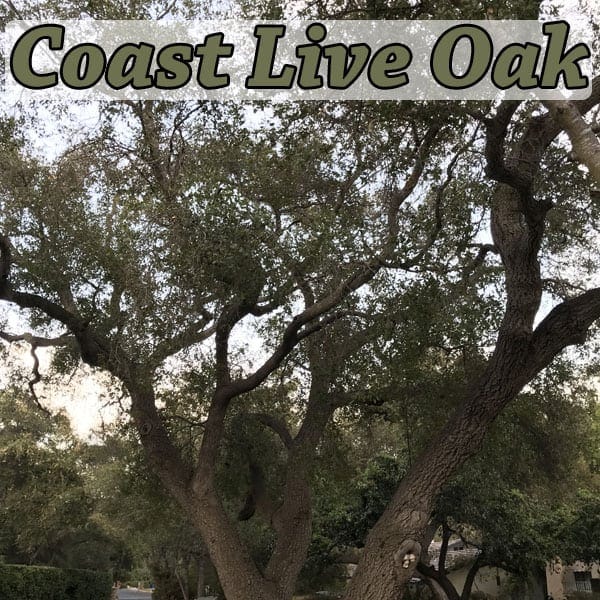Newsletter Articles
Coast Live Oak
By Richard Flowers, ACCNP- Green Thumb Nursery- Ventura
While puttering in the garden, I stop to take in the beauty and enjoyment of the majestic world I live in. Extending up from the ground is a massive, over one hundred year old “being” with deep furrowed bark and a thick trunk. Looking up I see the network of branches that forms a tapestry of beauty. The multiple trunks or branches reach 40 or more feet out in all directions and the height is 30 feet. Together with the spread and height coupled with its numerous serrated leaves this creature generates, it produces dense shade that provides a welcoming reprieve from the hot sun during summer. I glimpse and see squirrels scrambling these branches as highways to navigate. I hear birds in the canopy singing to their hearts desire. A woodpecker is knocking on the bark and between the branches I see patches of blue sky and the suns rays beaming down creating a shadow and silhouette of this marvelous organism called the Coast Live Oak.
Qurecus agrifolia or better known as Coast Live Oak is a beautiful California native evergreen oak that grows predominantly west of the Central Valley, as far north as Mendocino County, and as far south as northern Baja California in Mexico. This tree has the ability to thrive in most of Southern California gardening areas where mild winters prevail. They are adapted to growing in coastal areas (but not on the immediate shore), warm interior valleys (about 30 or 60 miles from the ocean), and the foothills. Coast Live Oak enjoys the summer climate afforded by ocean proximity, and it is somewhat tolerant of aerosol-borne sea salt. The coastal fog supplies relief from the rainless California summer heat.
Coast Live Oak typically has a much-branched trunk and reaches a mature height of 32-80 feet and can live around 250 years or more. What I like about Coast Live Oak is the form the mature trunk and branches produce. With age these majestic treasures are capable of harboring an impressive trunk diameter up to 9 to 13 feet. The picturesque trunk and branches may be highly contorted, massive and gnarled. The crown is broadly rounded, dense, and insanely beautiful, especially when aged 20 to 70 years.
Coast Live Oak tolerates a variety of soils but prefers a deep, well draining loam and rocky sites. In its native habitat it is normally found on coastal hills and plains, usually near year-round or perennial streams. Coast Live Oaks are fairly easy to grow. Under ideal conditions, water 1x per week the first year after planting, decreasing to about 1x per month after the first year, until the tree is about 10 feet tall. After that, it’s best to avoid direct summer water entirely. During less rainfall times it is best to plant Coast Live Oaks near an irrigated area. They’ll get the water they need by stretching their roots out to the wetter area, but remember to keep the area close to their trunk dry. Once they get their roots into the wetter areas, they’ll grow rapidly and stay healthy looking all year-round. Mature oaks require little maintenance or irrigation and are best left undisturbed. Changes in the water supply or grading of an established tree can seriously threaten its health and mortality. Young trees however need regular and deep watering to become established. In general, southern Californian oaks are drought tolerant and prefer a conservative summer water regime. Coast Live Oaks prefer to have their roots shaded, so it’s a good idea to surround young specimens with mulch, rocks, or smaller native plants that won’t crowd out the young tree but will provide shade to the roots. The best mulch is always thick layer of oak leaves. It is not necessary to fertilize oaks. They’ll amend the soil over time with their own leaves and build the natural fungus in the soil they need to thrive. Gradually, they become islands of natural fertility that improve the health of the nearby plants.
Fall is the best time to plant your Coast Live Oak. In the home landscape, try combining Coast Live Oak with Toyon, various Manzanitas, Coyote Bush, Buckwheat, Coast Sagebrush, Coffeeberry, Woolly Bluecurls, California Wild Rose, and Salvias. You are not only limited to native plants growing around your oak. Here are some non-native plant suggestions: African Boxwood, Heavenly Bamboo, Australian Fuchsia, and Dwarf Plumbago. Lots of other plants are suitable for this location as well. Bear in mind, when planting in the vicinity of this endemic species and to preserve them, use only drought tolerant plants within the range of their root systems (tree canopy). I recommend to plant sparingly when planting underneath Oaks or better yet, use nothing at all keeping it natural. For the bird and butterfly lover, this oak is an excellent addition to your garden because the acorns and pollen are excellent food sources.
I encourage you to plant Coast Live Oak to bring back the wildness and heritage of our state.
Do you like what you see? Sign up for our weekly newsletter to get content like this every week!

